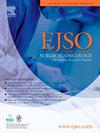A retrospective study evaluating surgical upstaging rates in low-risk DCIS patients meeting the eligibility criteria for active surveillance trials
IF 3.5
2区 医学
Q2 ONCOLOGY
引用次数: 0
Abstract
Background
The management of small low-to-medium grade ductal carcinoma in situ (DCIS) on core biopsy remains controversial. Four international studies are currently recruiting highly selected low-risk DCIS patients to compare active surveillance ( ± hormonal treatment) versus conventional treatment. In this study, we aim to determine the upstaging rate at a tertiary center among low-risk DCIS patients meeting eligibility criteria for active surveillance trials.
Methods
A retrospective study was undertaken of all patients diagnosed with small (<2 cm) low-medium grade DCIS patients at the European Institute of Oncology, Milan, from 2009 to 2019. All cases were classified as eligible based on the COMET, LORIS, LORD and LORETTA DCIS studies, according to their respective inclusion criteria.
Results
We identified 351 patients from a prospectively maintained database who were diagnosed with G1-G2 DCIS on core biopsy, with a median age of 55 years (range 45–82). The overall upstage/upgrade rate was 23.6 %. Of the 351 patients, sixty-four (18.2 %) were upstaged to invasive disease and nine-teen (5.4 %) were upgraded to grade 3 DCIS. It is worth noting a rate of 7.9 % of patients with >pT1c and 2.3 % of patients with nodal involvement at the time of surgery. On both univariable and multivariable analysis, no specific variable was found to be a statistically significant predictor for upstaging.
Conclusion
Over 23 % of patients with low-risk DCIS may be upgraded or upstaged at resection, especially towards invasive carcinoma (18.2 % of cases were staged to invasive cancer at surgical resection). These data suggest that active surveillance is not warranted in this highly selected group of low-risk DCIS patients. Stricter selection criteria must be considered to ensure appropriate treatment of such patients.
求助全文
约1分钟内获得全文
求助全文
来源期刊

Ejso
医学-外科
CiteScore
6.40
自引率
2.60%
发文量
1148
审稿时长
41 days
期刊介绍:
JSO - European Journal of Surgical Oncology ("the Journal of Cancer Surgery") is the Official Journal of the European Society of Surgical Oncology and BASO ~ the Association for Cancer Surgery.
The EJSO aims to advance surgical oncology research and practice through the publication of original research articles, review articles, editorials, debates and correspondence.
 求助内容:
求助内容: 应助结果提醒方式:
应助结果提醒方式:


